Initiation and Mechanisms of Plasticity in Bimetallic Al-Cu Composite
Abstract
:1. Introduction
2. Materials and Methods
2.1. MD Problem Statement
2.2. ANN-Based Description
3. Results
3.1. Stress-Strain Dependencies and Critical Stresses
3.2. Mechanisms of Plasticity in Al-Cu Bisystem
3.3. Development of Plasticity in Pure Metals
3.4. ANN Training and Strain Rate Dependence
3.5. Influence of Interface Orientation and Elevated Temperature
4. Discussion
5. Conclusions
Supplementary Materials
Author Contributions
Funding
Institutional Review Board Statement
Informed Consent Statement
Data Availability Statement
Conflicts of Interest
References
- Kunčická, L.; Kocich, R. Deformation behaviour of Cu-Al clad composites produced by rotary swaging. IOP Conf. Ser. Mater. Sci. Eng. 2018, 369, 012029. [Google Scholar] [CrossRef]
- Li, C.; Xu, C.; Zhou, Y.; Chen, D.; Wang, X.; Mi, Y. Atomic diffusion behavior in electromagnetic pulse welding. Mater. Lett. 2023, 330, 133242. [Google Scholar] [CrossRef]
- Mypati, O.; Anwaar, T.; Mitra, D.; Kanta Pal, S.; Srirangam, P. Characterization and modelling of Al and Cu busbar during charging and discharging of Li-ion battery for electric vehicles. Appl. Therm. Eng. 2023, 218, 119239. [Google Scholar] [CrossRef]
- You, J.; Zhao, Y.; Dong, C.; Su, Y. Improving the microstructure and mechanical properties of Al-Cu dissimilar joints by ultrasonic dynamic-stationary shoulder friction stir welding. J. Mater. Process. Technol. 2023, 311, 117812. [Google Scholar] [CrossRef]
- Guo, Y.; Li, W.-Q.; Liu, X.-G.; Sugio, K.; Ke, Y.-J.; Wang, K.-Y.; Liu, W.-C.; Sasaki, G. Effect of copper coating on interfacial properties, interfacial thermal resistance, microstructure evolution and mechanical properties of aluminum matrix composites. J. Alloys Compd. 2022, 917, 165376. [Google Scholar] [CrossRef]
- Abbasi, M.; Karimi Taheri, A.; Salehi, M.T. Growth rate of intermetallic compounds in Al/Cu bimetal produced by cold roll welding process. J. Alloys Compd. 2001, 319, 233–241. [Google Scholar] [CrossRef]
- Sheng, L.Y.; Yang, F.; Xi, T.F.; Lai, C.; Ye, H.Q. Influence of heat treatment on interface of Cu/Al bimetal composite fabricated by cold rolling. Compos. Part B 2011, 42, 1468–1473. [Google Scholar] [CrossRef]
- Eizadjou, M.; Kazemi Talachi, A.; Danesh Manesh, H.; Shakur Shahabi, H.; Janghorban, K. Investigation of structure and mechanical properties of multi-layered Al/Cu composite produced by accumulative roll bonding (ARB) process. Compos. Sci. Technol. 2008, 68, 2003–2009. [Google Scholar] [CrossRef]
- Xue, P.; Xiao, B.L.; Ni, D.R.; Ma, Z.Y. Enhanced mechanical properties of friction stir welded dissimilar Al-Cu joint by intermetallic compounds. Mater. Sci. Eng. A 2010, 527, 5723–5727. [Google Scholar] [CrossRef]
- Tan, C.W.; Jiang, Z.G.; Li, L.Q.; Chen, Y.B.; Chen, X.Y. Microstructural evolution and mechanical properties of dissimilar Al-Cu joints produced by friction stir welding. Mater. Des. 2013, 51, 466–473. [Google Scholar] [CrossRef]
- Hoseini Athar, M.M.; Tolaminejad, B. Weldability window and the effect of interface morphology on the properties of Al/Cu/Al laminated composites fabricated by explosive welding. Mater. Des. 2015, 86, 516–525. [Google Scholar] [CrossRef]
- Klinkov, S.V.; Kosarev, V.F.; Sova, A.A.; Smurov, I. Deposition of multicomponent coatings by Cold Spray. Surf. Coat. Technol. 2008, 202, 5858–5862. [Google Scholar] [CrossRef]
- Hussain, T.; McCartney, D.G.; Shipway, P.H.; Zhang, D. Bonding mechanisms in cold spraying: The contributions of metallurgical and mechanical components. J. Therm. Spray Technol. 2009, 18, 364–379. [Google Scholar] [CrossRef]
- Winnicki, M.; Małachowska, A.; Baszczuk, A.; Rutkowska-Gorczyca, M.; Kukla, D.; Lachowicz, M.; Ambroziak, A. Corrosion protection and electrical conductivity of copper coatings deposited by low-pressure cold spraying. Surf. Coat. Technol. 2017, 318, 90–98. [Google Scholar] [CrossRef]
- Pogorelko, V.V.; Mayer, A.E.; Krasnikov, V.S. High-speed collision of copper nanoparticle with aluminum surface: Molecular dynamics simulation. Appl. Surf. Sci. 2016, 390, 289–302. [Google Scholar] [CrossRef]
- Pogorelko, V.V.; Mayer, A.E.; Krasnikov, V.S. High-speed collision of copper nanoparticles with aluminum surface: Inclined impact, interaction with roughness and multiple impact. Comput. Mater. Sci. 2018, 142, 108–121. [Google Scholar] [CrossRef]
- Li, X.; Sheinerman, A.G.; Zhu, Z.; Zhao, F. Tension-compression asymmetry of grain-boundary sliding: A molecular dynamics study. Mater. Lett. 2022, 325, 132822. [Google Scholar] [CrossRef]
- Wang, K.; Xu, Y.; Zhang, W.; Xu, J. The impact of structural units on the dislocation nucleation of bi-crystal copper grain boundary. Comput. Mater. Sci. 2023, 218, 111900. [Google Scholar] [CrossRef]
- Zhang, Y.; Ding, K.; Stangebye, S.; Chen, D.; Kacher, J.; Pierron, O.; Zhu, T. Atomistic modeling of surface and grain boundary dislocation nucleation in FCC metals. Acta Mater. 2022, 237, 118155. [Google Scholar] [CrossRef]
- Hua, A.; Zhao, J. Shear direction induced transition mechanism from grain boundary migration to sliding in a cylindrical copper bicrystal. Int. J. Plast. 2022, 156, 103370. [Google Scholar] [CrossRef]
- Nenninger, T.; Sansoz, F. Local atomic environment analysis of short and long-range solute-solute interactions in a symmetric tilt grain boundary. Scr. Mater. 2023, 222, 115045. [Google Scholar] [CrossRef]
- Ma, N.; Zhao, D.; Shi, C.; He, C.; Liu, E.; Sha, J.; Li, Y.; Zhao, N. Unraveling the enhanced stability and strength of Al Σ9 (221)[110] symmetric tilt grain boundary with Mg segregation. J. Mater. Sci. 2022, 57, 21591–21606. [Google Scholar] [CrossRef]
- Yao, B.N.; Liu, Z.R.; Legut, D.; Kong, X.F.; Germann, T.C.; Zhang, H.J.; Zhang, R.F. Cooperative roles of stacking fault energies on dislocation nucleation at bimetal interface through tunable potentials. Comput. Mater. Sci. 2021, 193, 110416. [Google Scholar] [CrossRef]
- Lin, B.; Li, J.; Wang, Z.; Wang, J. Dislocation nucleation from Zr-Nb bimetal interfaces cooperating with the dynamic evolution of interfacial dislocations. Int. J. Plast. 2020, 135, 102830. [Google Scholar] [CrossRef]
- Shen, X.P.; Yao, B.N.; Liu, Z.R.; Legut, D.; Zhang, H.J.; Zhang, R.F. Mechanistic insights into interface-facilitated dislocation nucleation and phase transformation at semicoherent bimetal interfaces. Int. J. Plast. 2021, 146, 103105. [Google Scholar] [CrossRef]
- Liu, Z.R.; Yao, B.N.; Legut, D.; Kong, X.F.; Germann, T.C.; Zhang, H.J.; Zhang, R.F. Mechanistic understanding of the size effect on shock facilitated dislocation nucleation at semicoherent interfaces. Scr. Mater. 2020, 178, 457–462. [Google Scholar] [CrossRef]
- Ogata, S.; Li, J.; Yip, S. Ideal pure shear strength of aluminum and copper. Science 2002, 298, 807–811. [Google Scholar] [CrossRef] [Green Version]
- Mayer, A.E.; Krasnikov, V.S.; Pogorelko, V.V. Dislocation nucleation in Al single crystal at shear parallel to (111) plane: Molecular dynamics simulations and nucleation theory with artificial neural networks. Int. J. Plast. 2021, 139, 102953. [Google Scholar] [CrossRef]
- Mayer, A.E.; Krasnikov, V.S.; Pogorelko, V.V. Homogeneous nucleation of dislocations in copper: Theory and approximate description based on molecular dynamics and artificial neural networks. Comput. Mater. Sci. 2022, 206, 111266. [Google Scholar] [CrossRef]
- Plimpton, S.J. Fast parallel algorithms for short-range molecular dynamics. J. Comp. Phys. 1995, 117, 1–19. [Google Scholar] [CrossRef]
- Apostol, F.; Mishin, Y. Interatomic potential for the Al-Cu system. Phys. Rev. B. 2011, 83, 054116. [Google Scholar] [CrossRef] [Green Version]
- Mayer, A.E.; Mayer, P.N.; Lekanov, M.V.; Panchenko, B.A. incipience of plastic flow in aluminum with nanopores: Molecular dynamics and machine-learning-based description. Metals 2022, 12, 2158. [Google Scholar] [CrossRef]
- Lekanov, M.V.; Mayer, A.E.; Pogorelko, V.V. Machine-learning-based model of dislocation plasticity in finite strains and its application to the problem of radial compression of aluminum cylindrical shell. Int. J. Plast. 2023; submitted. [Google Scholar]
- Mayer, A.E.; Lekanov, M.V.; Grachyova, N.A.; Fomin, E.V. Machine-learning-based model of elastic—Plastic deformation of copper for application to shock wave problem. Metals 2022, 12, 402. [Google Scholar] [CrossRef]
- Dewaele, A.; Loubeyre, P.; Mezouar, M. Equations of state of six metals above 94 GPa. Phys. Rev. B 2004, 70, 094112. [Google Scholar] [CrossRef] [Green Version]
- Greeff, C.W.; Boettger, J.C.; Graf, M.J.; Johnson, J.D. Theoretical investigation of the Cu EOS standard. J. Phys. Chem. Solids 2006, 67, 2033–2040. [Google Scholar] [CrossRef]
- Kelchner, C.L.; Plimpton, S.J.; Hamilton, J.C. Dislocation nucleation and defect structure during surface indentation. Phys. Rev. B 1998, 58, 11085. [Google Scholar] [CrossRef]
- Stukowski, A.; Bulatov, V.V.; Arsenlis, A. Automated identification and indexing of dislocations in crystal interfaces. Model. Simul. Mater. Sci. Eng. 2012, 20, 085007. [Google Scholar] [CrossRef]
- Stukowski, A. Visualization and analysis of atomistic simulation data with OVITO—The Open Visualization Tool. Model. Simul. Mater. Sci. Eng. 2010, 18, 015012. [Google Scholar] [CrossRef]
- Thompson, A.P.; Plimpton, S.J.; Mattson, W. General formulation of pressure and stress tensor for arbitrary many-body interaction potentials under periodic boundary conditions. J. Chem. Phys. 2009, 131, 154107. [Google Scholar] [CrossRef] [Green Version]
- Goodfellow, I.; Bengio, Y.; Courville, A. Deep Learning; MIT Press: Cambridge, MA, USA, 2016; Available online: www.deeplearningbook.org (accessed on 26 December 2022).
- Nielsen, M. Neural Networks and Deep Learning. 2019. Available online: http://neuralnetworksanddeeplearning.com (accessed on 26 December 2022).
- Gracheva, N.A.; Lekanov, M.V.; Mayer, A.E.; Fomin, E.V. Application of neural networks for modeling shock-wave processes in aluminum. Mech. Solids 2021, 56, 326–342. [Google Scholar] [CrossRef]
- Nguyen, T.; Fensin, S.J.; Luscher, D.J. Dynamic crystal plasticity modeling of single crystal tantalum and validation using Taylor cylinder impact tests. Int. J. Plast. 2021, 139, 102940. [Google Scholar] [CrossRef]
- Polsin, D.N.; Fratanduono, D.E.; Rygg, J.R.; Lazicki, A.; Smith, R.F.; Eggert, J.H.; Gregor, M.C.; Henderson, B.H.; Delettrez, J.A.; Kraus, R.G.; et al. Measurement of Body-Centered-Cubic Aluminium at 475 GPa. Phys. Rev. Lett. 2017, 119, 175702. [Google Scholar] [CrossRef] [Green Version]
- Fiquet, G.; Narayana, C.; Bellin, C.; Shukla, A.; Estѐve, I.; Ruoff, A.L.; Garbarino, G.; Mezouar, M. Structural phase transitions in aluminium above 320 GPa. Comptes Rendus Geosci. 2019, 351, 243–252. [Google Scholar] [CrossRef]
- He, L.; Polsin, D.; Zhang, S.; Collins, G.W.; Abdolrahim, N. Phase transformation path in Aluminum under ramp compression; simulation and experimental study. Sci. Rep. 2022, 12, 18954. [Google Scholar] [CrossRef] [PubMed]
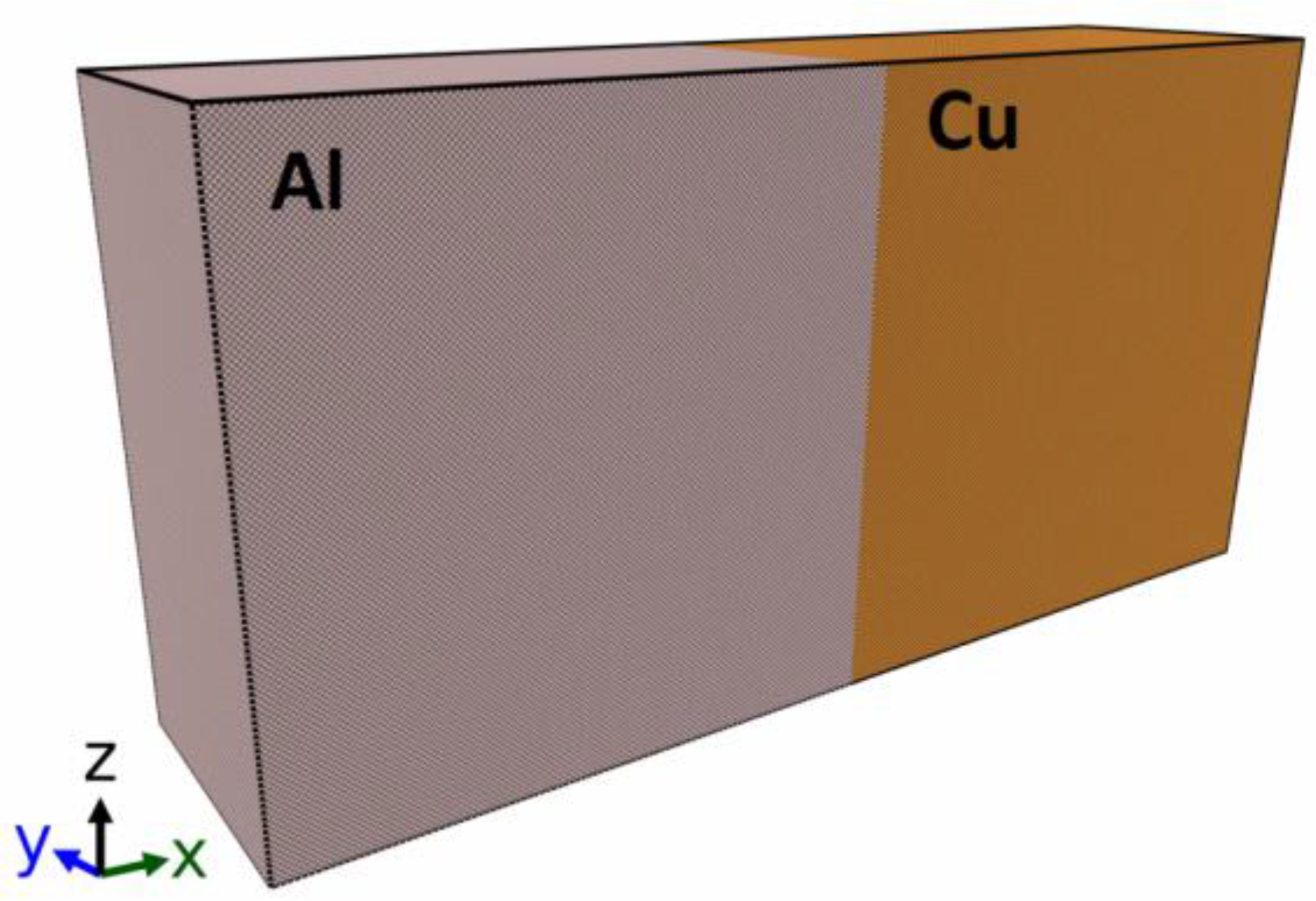




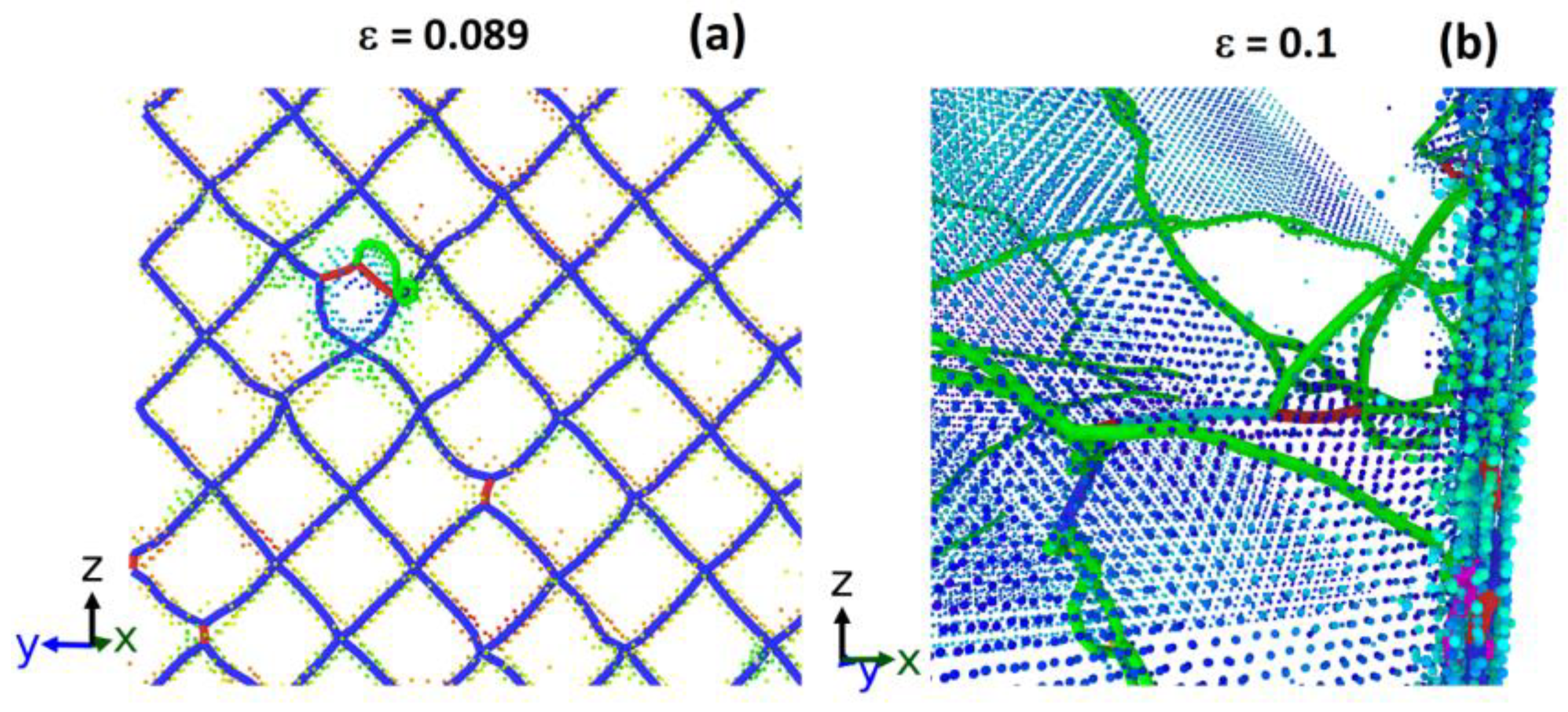


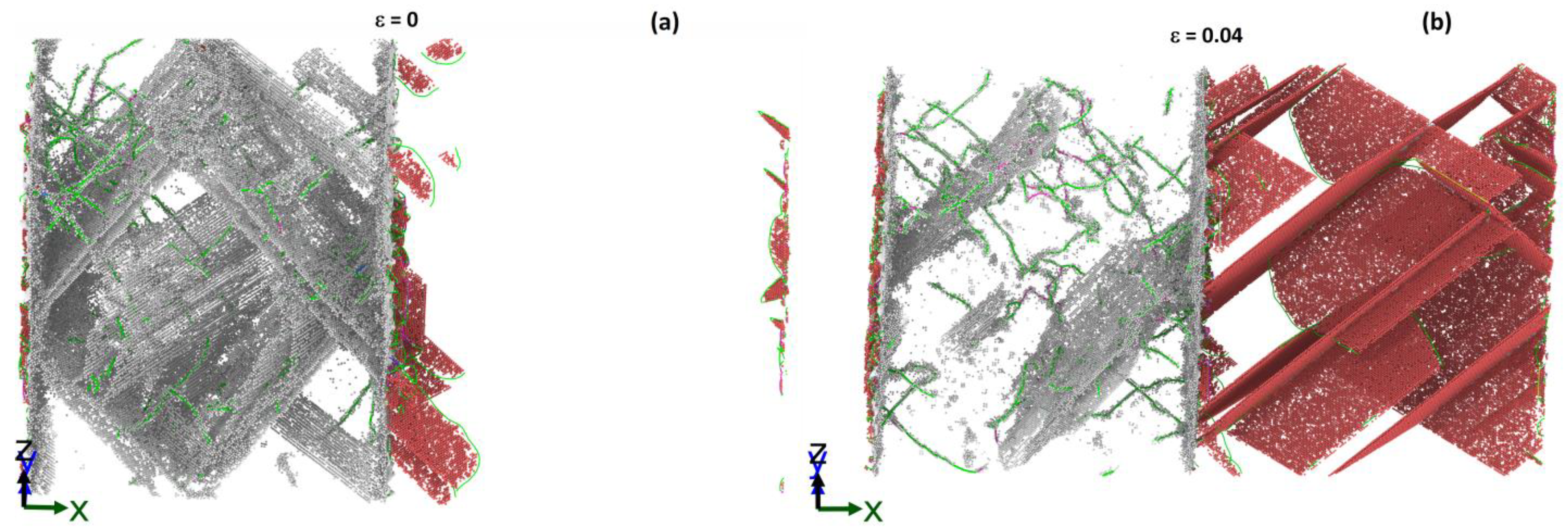

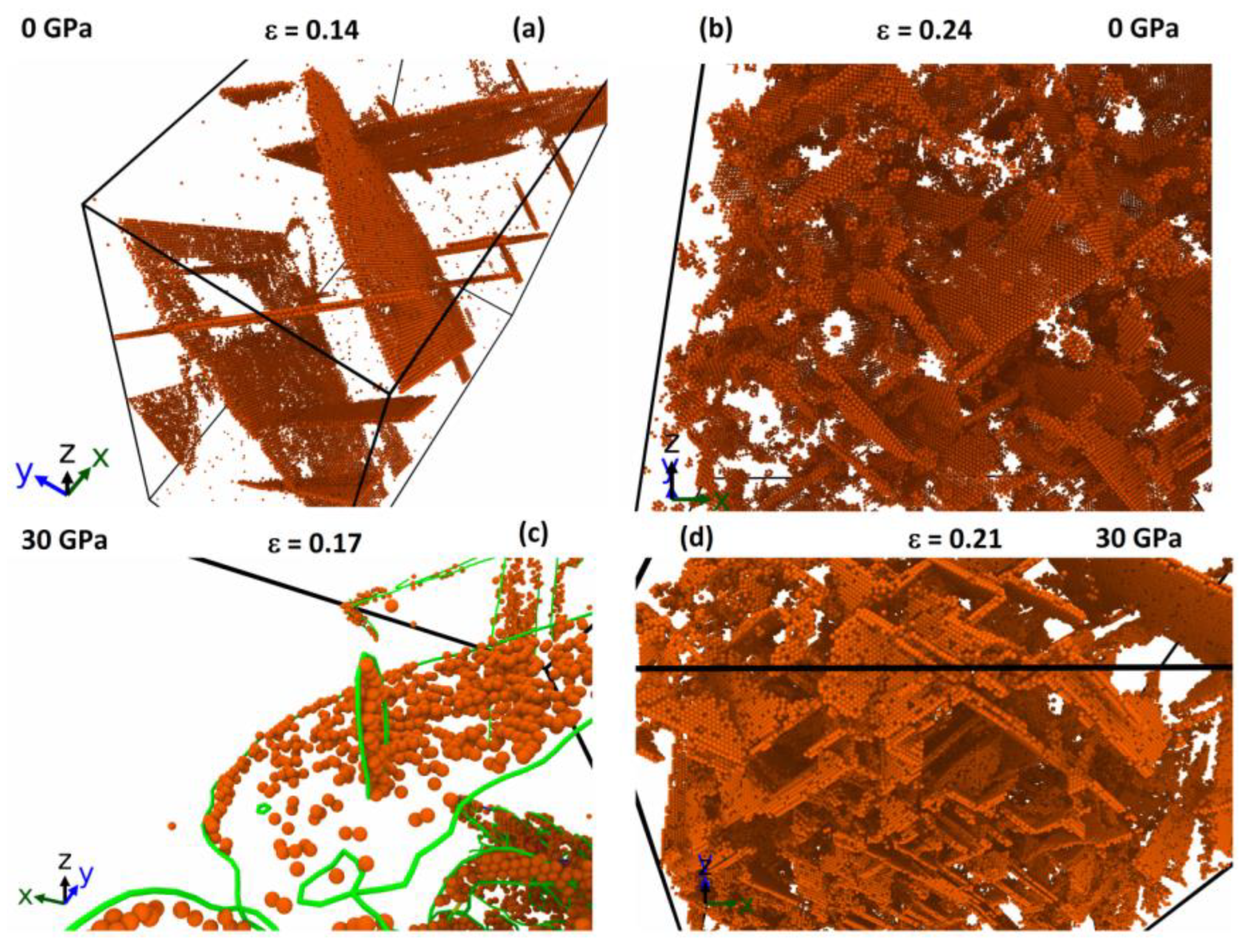

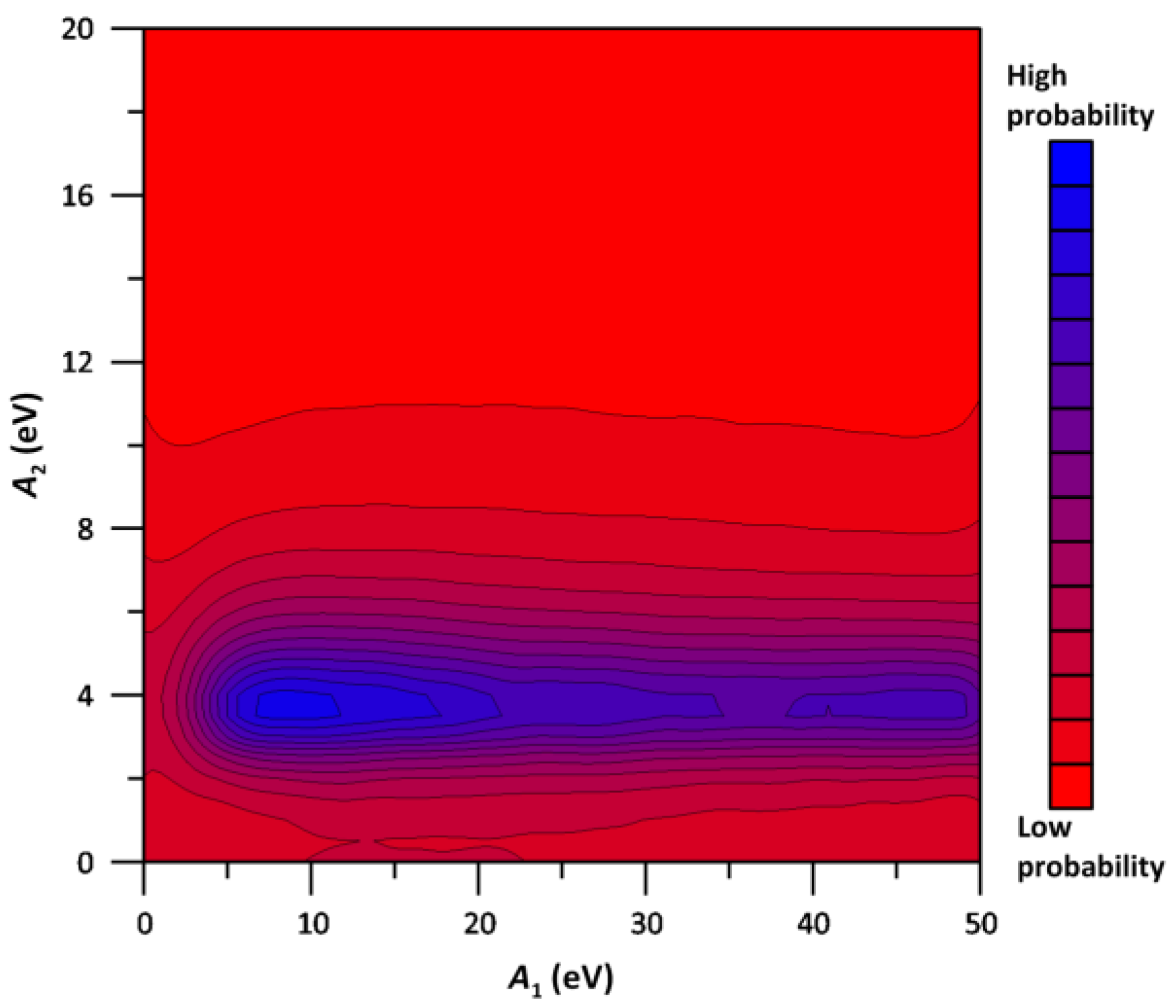
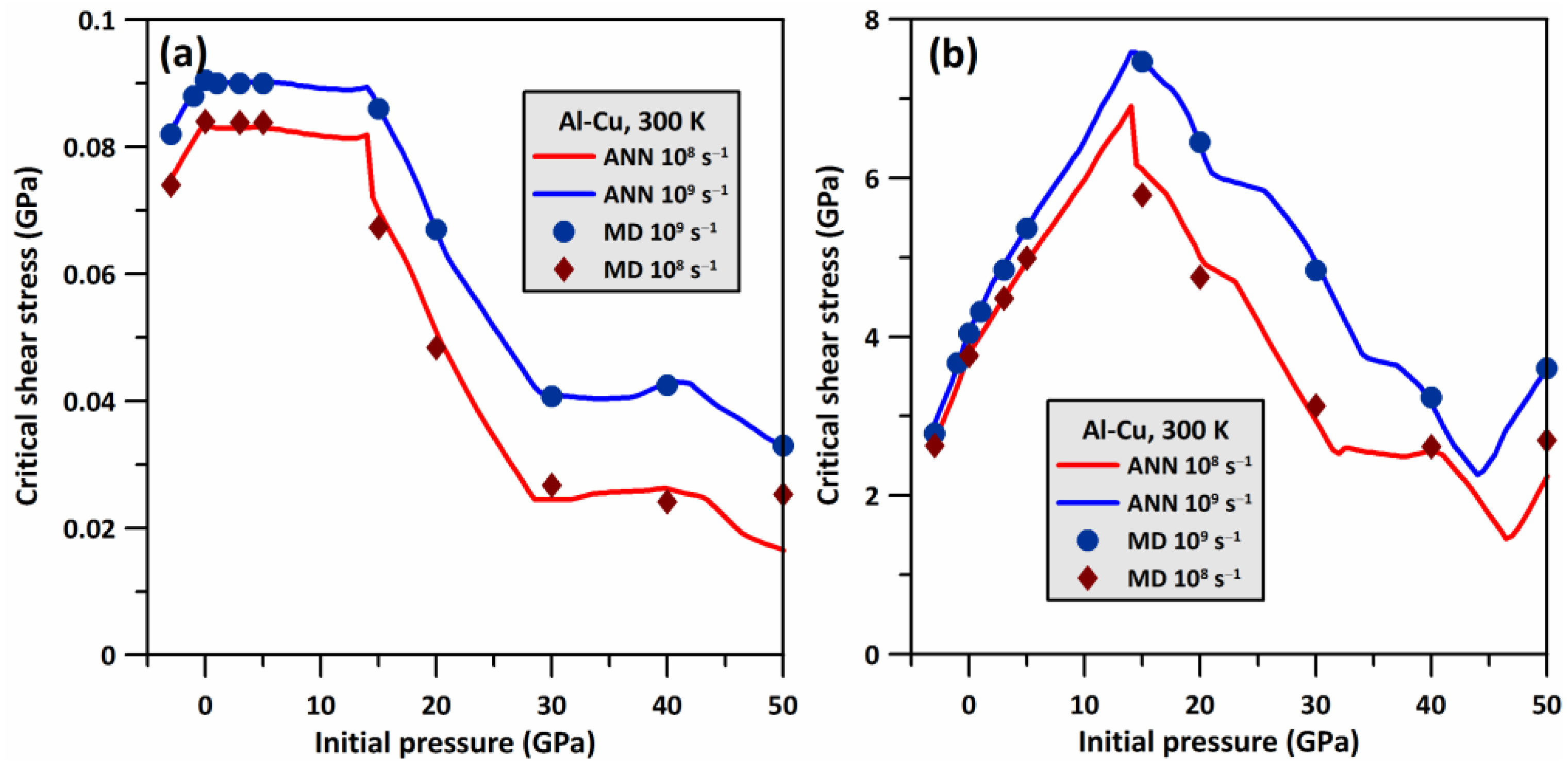
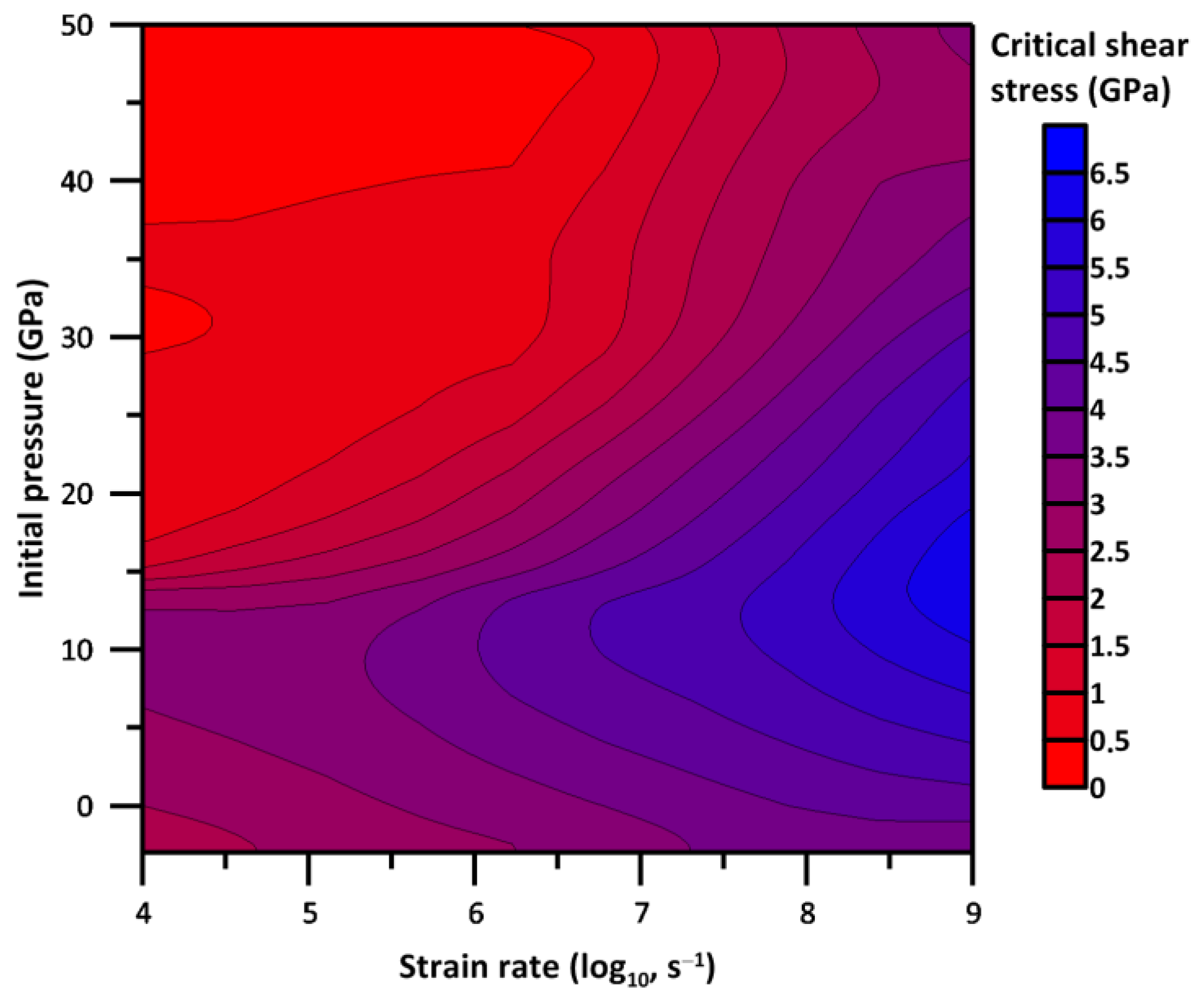
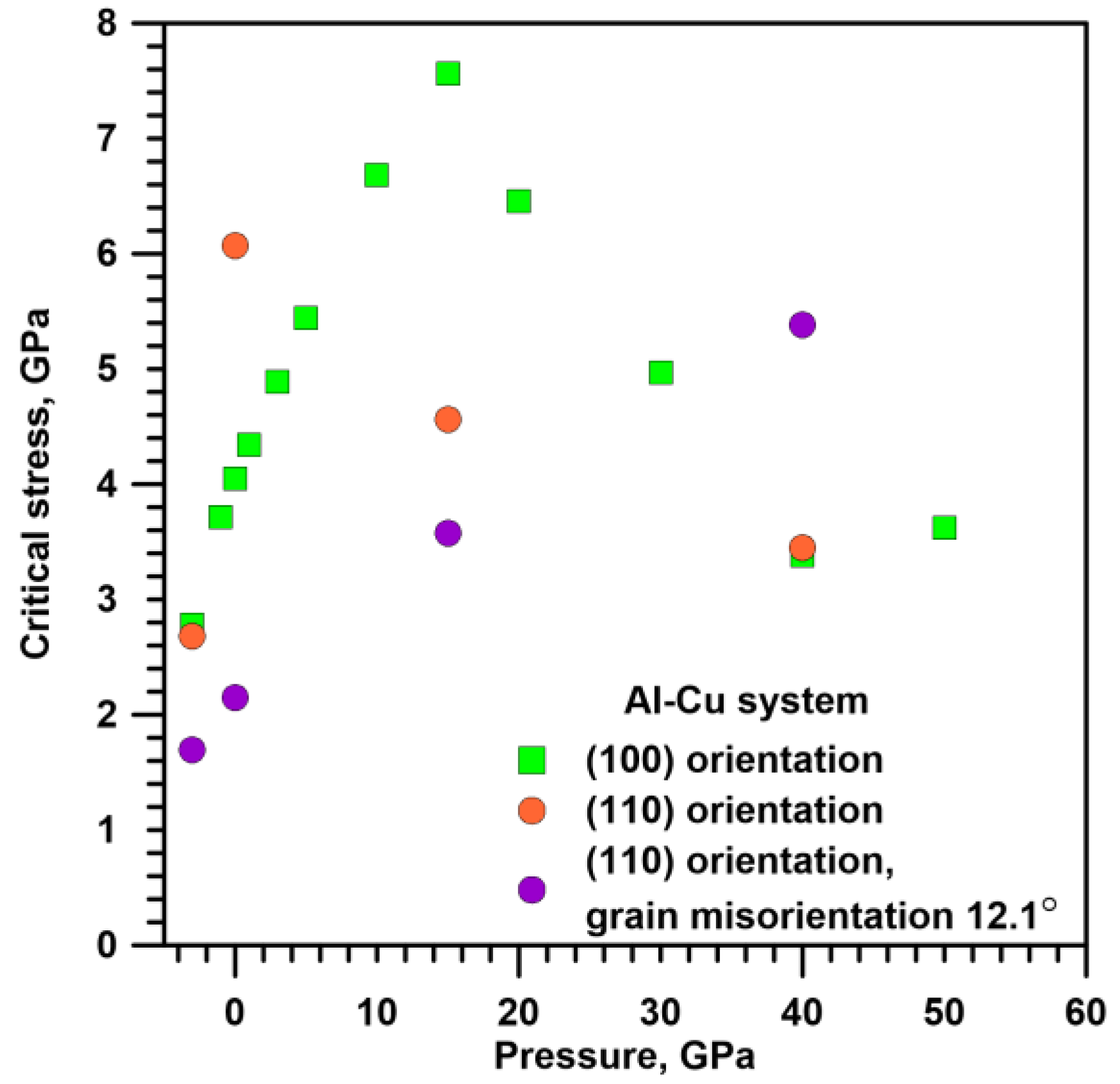
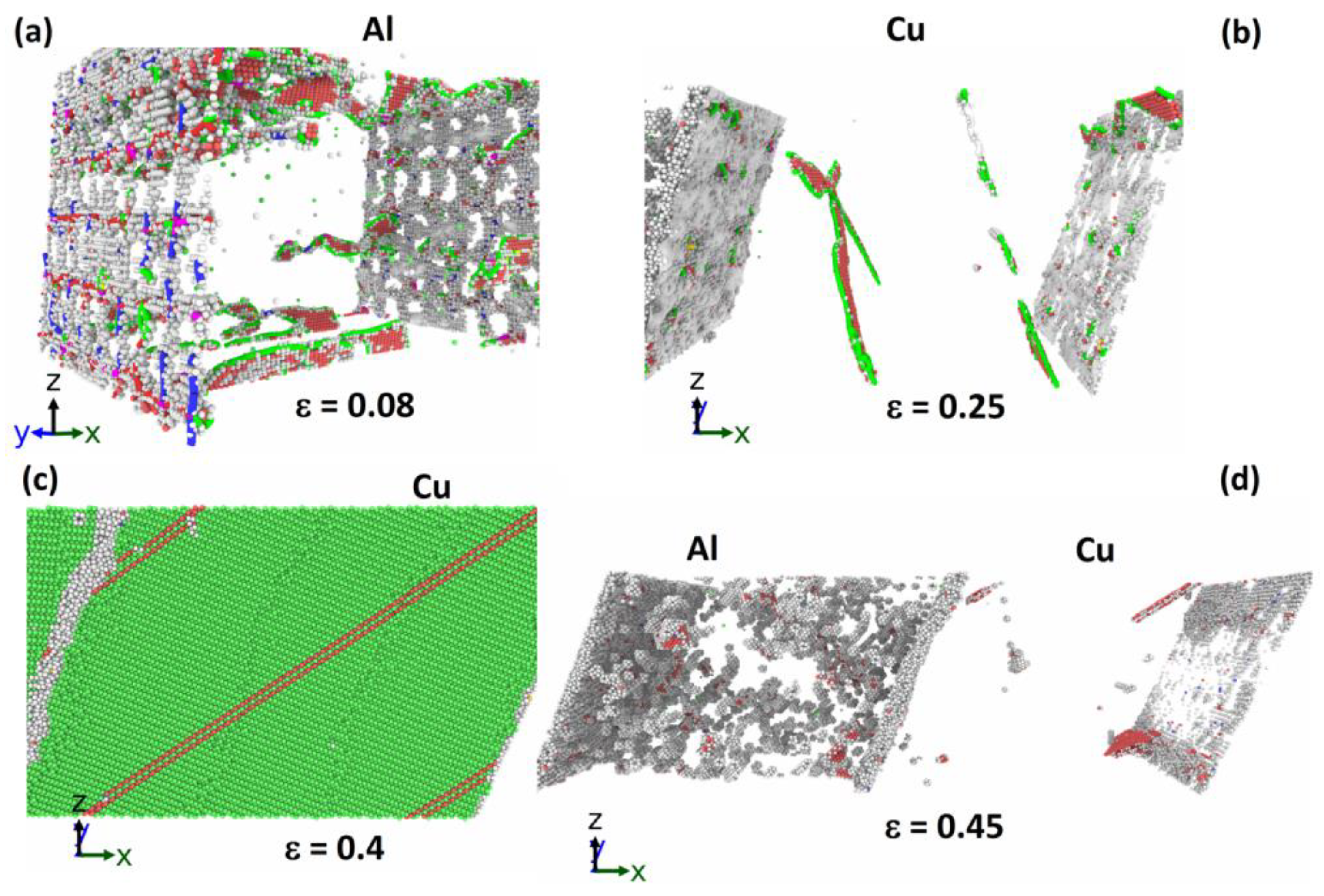


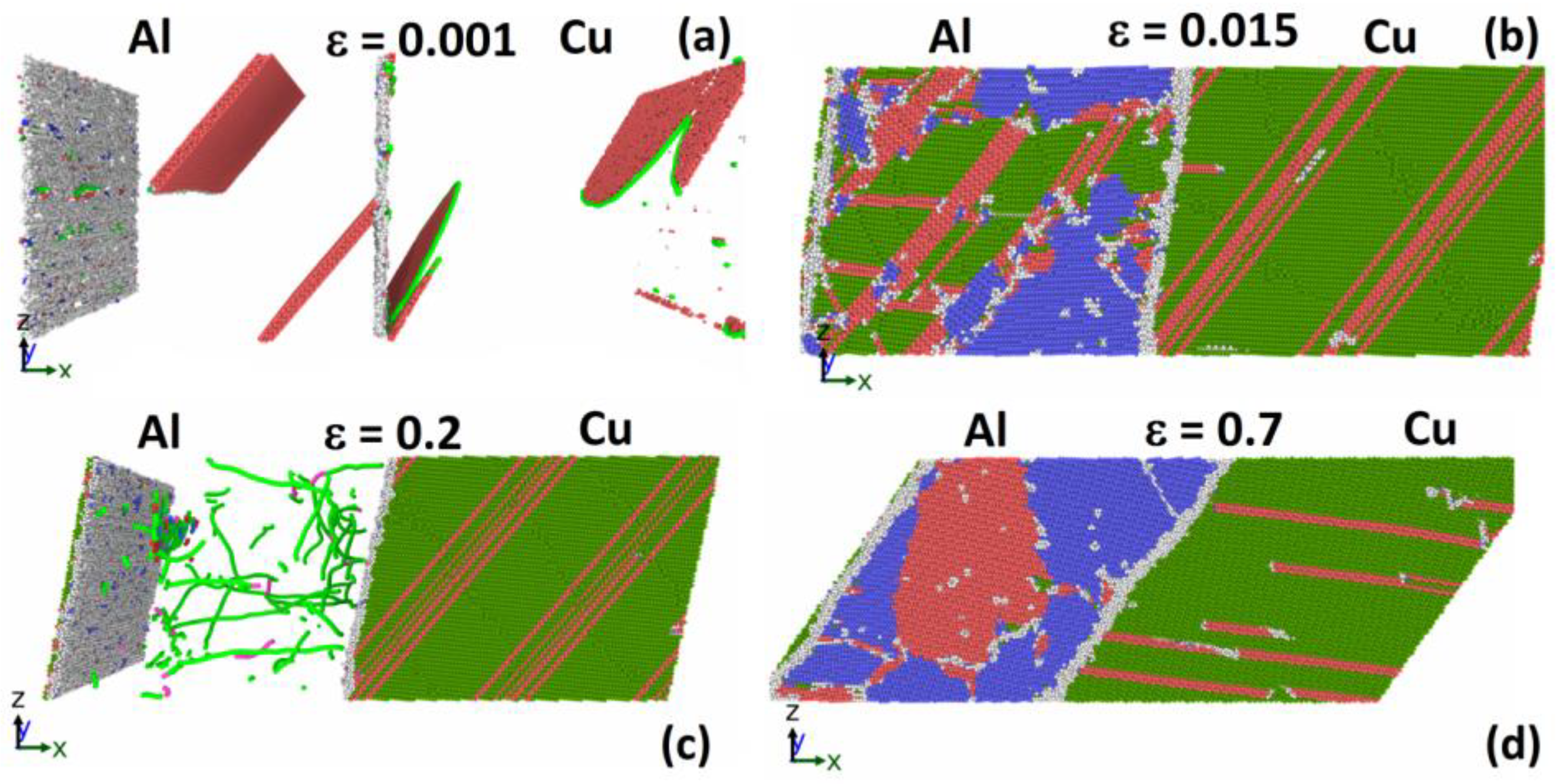
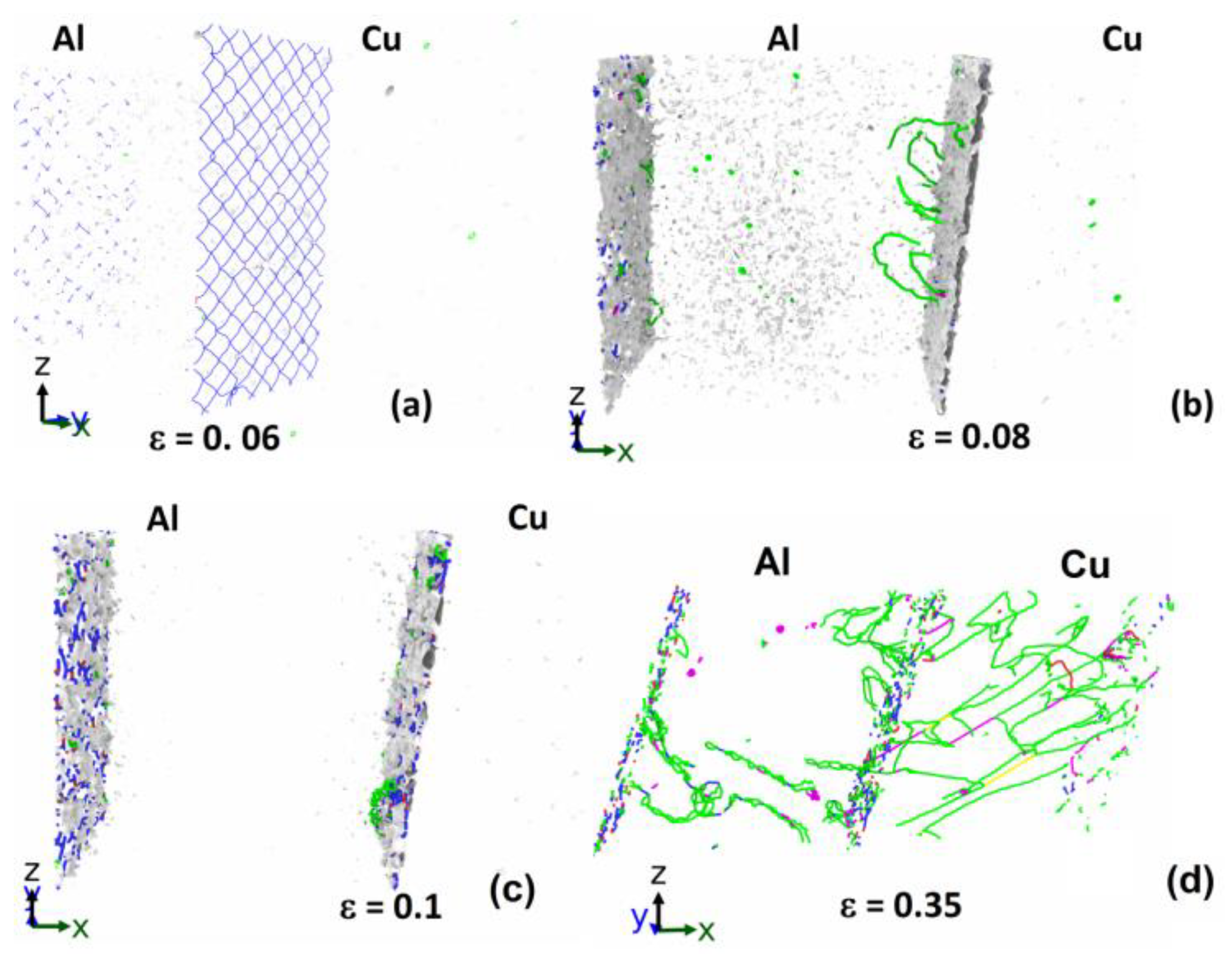
| System | ||
|---|---|---|
| Al + Cu | 8.2 | 3.6 |
| Al | 6.6 | 6.6 |
| Cu | 8.4 | 8.4 |
Disclaimer/Publisher’s Note: The statements, opinions and data contained in all publications are solely those of the individual author(s) and contributor(s) and not of MDPI and/or the editor(s). MDPI and/or the editor(s) disclaim responsibility for any injury to people or property resulting from any ideas, methods, instructions or products referred to in the content. |
© 2023 by the authors. Licensee MDPI, Basel, Switzerland. This article is an open access article distributed under the terms and conditions of the Creative Commons Attribution (CC BY) license (https://creativecommons.org/licenses/by/4.0/).
Share and Cite
Krasnikov, V.S.; Mayer, A.E. Initiation and Mechanisms of Plasticity in Bimetallic Al-Cu Composite. Metals 2023, 13, 102. https://doi.org/10.3390/met13010102
Krasnikov VS, Mayer AE. Initiation and Mechanisms of Plasticity in Bimetallic Al-Cu Composite. Metals. 2023; 13(1):102. https://doi.org/10.3390/met13010102
Chicago/Turabian StyleKrasnikov, Vasiliy S., and Alexander E. Mayer. 2023. "Initiation and Mechanisms of Plasticity in Bimetallic Al-Cu Composite" Metals 13, no. 1: 102. https://doi.org/10.3390/met13010102






